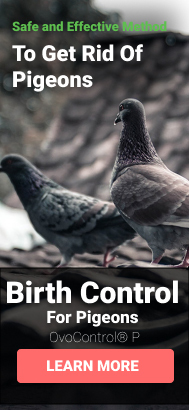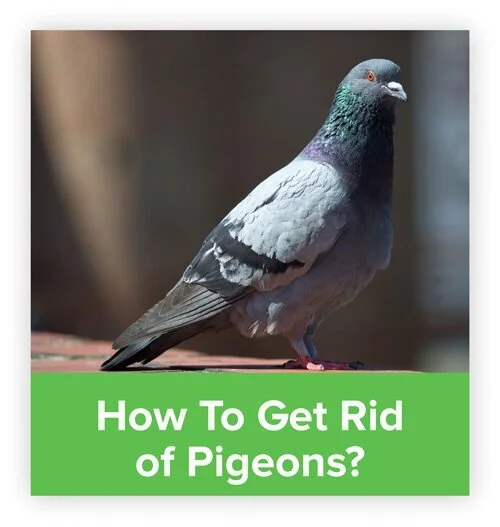How to Get Rid of Pigeons - Overview of All Available Solutions
Last updated on
Written by Erick Wolf
“one pigeon is no problem….
the problem is there is no such thing as one pigeon”
Are you in search of a solution on how to get rid of pigeons from your residential or commercial property? There are several methods that are proven to be effective - bird gel, electric and visual deterrents, bird wires and spikes, sonic and ultrasonic deterrents, bird netting, bird hazers, and the most humane option - bird birth control. These are the best solutions available to get rid of pigeons.
In this article, we will discuss how to get rid of pigeons using these methods so that you can easily find the most effective solution for your scenario.
Table Of Contents
How to Get Rid of Pigeons?
Culling Pigeons
- this method includes shooting, poisoning, using traps and even raptors
2.Reducing Pigeon Reproduction
- this method includes using pigeon birth control, nest destruction and dovecotes combined with egg removal or replacement
3.
Physically Excluding Pigeons
- this method includes using spikes, wires, slides and shock tracks to keep pigeons away
4.
Using Deterrents
-this method includes sonic and ultrasonic emitters, effigies, reflected and direct light sources, propane cannons and trained raptors to deter pigeons
5.
Using Repellents
- this method includes using gels and pastes, optical gels, fogs and vapors to deter pigeons
Comparison Table of 5 Main Methods to Get Rid of Pigeons
| Method/Product | Best Used For | Advantages | Disadvantages |
| Culling | |||
| Shoot | Killing birds | Immediate action, low cost | Generally prohibited in public. Represents a harvest as opposed to a control program |
| Poison | Killing birds | Immediate action | Non-target risks; socially unacceptable, short-term solution; dead and dying birds |
| Trap and euthanize | Killing birds | Immediate action | Often unacceptable where people are present. Short-term effects; birds get “trap shy” |
| Raptors | Predator and prey | Pigeons are a natural prey species; environmentally sound solution | Mating pairs are difficult to attract under most urban conditions. Raptors migrate and will leave the area part of the year |
| Reduce Reproduction | |||
| Birth Control | Abatement alternative | Gradually but predictably unwinds the pigeon population | Takes some time to work |
| Nest destruction | Destroy individual nests | Best for a small number of nests where exclusion will be installed | Completely ineffective since the mating pair will just build new ones. |
| Dovecots combined with egg removal or replacement | Commune with nature in a park | Provides a safe and secure way of harvesting eggs | Ineffective at controlling a population of pigeons; only provides extra housing for the birds. |
| Physical Exclusion | |||
| Spikes | Rails, perching areas | Inexpensive; can be highly effective under the right set of conditions; easy installation | In best case, will only move birds to the next best location |
| Bird Wire | Rails, fences, rooflines, perching areas | Useful tool to keep pigeons off perching areas. | More complex installation especially on rooflines |
| Slides | Narrow perching areas | Inexpensive and relatively easy installation | Only suitable under the appropriate conditions where a slide can be installed. |
| Netting | Gold standard for physically excluding birds from both large and small areas and structures | Tangible and immediate effect; can represent a permanent fix for problem birds. | Costly installation requiring professionals. Moves the problem to neighboring structures or facilities |
| Shock track systems | Rails, perching and loafing areas and surfaces | Highly effective in keeping birds off landing and perching areas | Equipment can be complex. Professional installation normally required. More costly than spikes |
| Deterrents | |||
| Sonic and ultrasonic emitters | Aural harassment | Can be used in larger areas where exclusion is not practical | Birds acclimate to the sounds |
| Effigies – plastic owl, rubber snake | Visual harassment | Can be effective short term | Birds acclimate to effigies |
| Reflected and direct light sources | Visual harassment | Can be effective long-term under appropriate conditions | Costs have a wide range; from shiny pie plates or CD’s to industrial lasers |
| Propane cannon | Harassment | Tangible and immediate effects | Birds acclimate and eventually ignore the noise; not suitable for urbanized areas |
| Trained raptors | Harassment with predators | Pigeons will flee raptors | Pigeons come right back when the birds of prey go home |
| Repellents | |||
| Gels and pastes | Perching areas | Inexpensive | Can kill smaller birds; requires consistent reapplication |
| Optical Gel | Perching and loafing areas | Small and inexpensive; easy to install | Not necessarily appropriate for larger areas. Intensive cleaning required. |
| Fogs and vapors | Large indoor areas | Ideal for large volume structures | Inconsistent action |
How to Get Rid of Pigeons from a Balcony
Getting rid of pigeons from small areas like balconies can be resolved with relatively simple common-sense solutions.
Wires. You can use a wire coil or stainless-steel wire to deter pigeons perching on rails.
Shock Track. Several suppliers offer a “shock track” system to keep birds off balconies. The shock track does not hurt the bird but provides enough stimulation to make the targeted perching area unattractive.
Netting. Consider using a netting system to physically exclude the birds from balconies. This is the costliest alternative, although if installed properly it's 100% effective. Newer versions of netting are virtually invisible.
Sound or reflected light. The easiest way to deter pigeons from your patio, deck, or balcony, is with sound or reflected light. You can achieve this with a wind chime, Mylar balloon, aluminum foil pans or even hanging CD’s. The reflected light disorients the birds.
5. Plastic owl or rubber snake. Consider using scarecrows (“effigies”). The most common example is a plastic owl or rubber snake. Unfortunately, the effects will most likely be short-lived. The pigeons come to recognize the scarecrow as something that is not a threat.
6. Spikes. Consider using anti-perching spikes that you can attach anywhere the birds like to perch. Spikes are best advised for limited areas where the goal is to move the birds someplace else. They are available in different materials from plastic to stainless steel.
7. Gel Repellants. You can use gel repellants to ledges where pigeons perch. The gel makes the surface sticky and the birds will try to avoid it. Unfortunately, dust and debris take their toll and reapplication is often necessary. The application of gel repellants is not recommended where there are smaller birds. They can permanently get stuck in the goo.
How to Get Rid of Pigeons on Roofs
If you have a pigeon problem on your roof, there are a few things you can do to get rid of them. First, try to figure out how they are getting onto your roof in the first place. If you have any holes or cracks that they can use as an entry point, seal them up with some wire mesh or caulking. You can also try installing a physical barrier like a wire fence around the perimeter of your roof.
Keeping pigeons off a roof can be far more challenging. Here are some popular methods you might consider if you wonder how to get rid of pigeons on roofs:
Consider using a wire coil or stainless-steel wire to deter pigeons from perching on the ridge(s).
A “shock track” system might keep birds off rooftops
Using wire or netting is appropriate for a roof design that incorporates nooks. You can also apply nets where the pigeons can construct a nest.
Solar panels provide excellent harborage for pigeons. Metal grid netting is the most effective method to limit access to the birds.
Flat commercial roof styles have their own set of challenges. The first option is to electrify the parapet perching areas. The second option is to install simple spikes. Be aware that pigeons enjoy the comfort of HVAC installations. As a solution, consider netting these units.
How to Get Rid of Pigeons at Industrial Facilities
The basic nature and scope of modern industrial facilities make them highly attractive to pigeons. The design of these facilities is most often open which allows the birds ready ingress and egress. More importantly, pipes, beams, poles, and catwalks offer a wide range of harborage and nesting options. Food sources are typically located nearby and as mobile pests, pigeons can move around freely from one area of the plant to the next.
Pigeons can represent a costly nuisance for plants, and in many cases have been at the facility ever since it was built, so industrial bird control is essential. Over time, the nests, feces, and debris can cause considerable damage to a plant’s mechanical and electrical components. Furthermore, the birds’ droppings and other debris add additional health hazards to an already hazardous area.
Most conventional methods of pigeon mitigation offer little comfort to an industrial facility and decision makers often select culling solutions since everything else is either prohibitively costly or impractical. Methods such as trapping and poisoning the birds may help alleviate the problem temporarily, however, due to their rapid breeding, pigeons always return and repopulate the very attractive site in a few weeks or months.
While highly effective at smaller sites, physical exclusion is typically not an option at a larger plant. It is simply impossible to cover an oil refinery or power plant with a net.
The more common solutions for smaller scale facilities are only appropriate for the resolution of isolated problems at a larger plant. An area where there is zero tolerance for birds mandates physical exclusion to keep them out, while the overall control strategy needs to focus on abatement.
The following graphic provides an outline of the various options for bird abatement. There are just two alternatives:
Increase mortality with the common culling methods, trap, shoot or poison
Reduce reproduction with a contraceptive.
The most effective method at a complex installation is a control program based on OvoControl. A contraceptive has exceptional utility in these large sites where conventional bird control methods may not be appropriate or cost effective.
While baiting birds without killing them may seem counterintuitive to some, the successful long-term use of OvoControl at a wide range of different industrial facilities demonstrates otherwise.
OvoControl provides a safe, easy-to-use, and effective solution for everything from oil refineries to power plants to control the pigeon population for good.
OvoControl reduces the population naturally, through attrition, over time. With continued use, the population declines at a rate of roughly 50%, annually. With a successful contraceptive program, industrial facilities will ultimately drive their pigeon population down by 90 to 95%.
Furthermore, many industrial facilities often have challenging sites for environmental stewardship. Thankfully, OvoControl represents an environmentally benign pigeon mitigation strategy which does not pose secondary risks to raptors or scavengers.
Conclusion
No Single Method or Solution will solve all pigeon problems
Short of exterminating the birds, there is no foolproof way to get rid of all of them. Pigeons have accompanied mankind for thousands of years and, like rats, are not leaving anytime soon. Unfortunately, even the effects of lethal methods are only effective in the short-term as the remaining flock rapidly breeds back the ones that are missing. Lethal solutions often represent a “harvest” of pigeons as opposed to an actual control program. Both larger and smaller problems can be solved with the techniques outlined above although all but the simplest sites require some observation and planning to develop a safe and effective strategy for success.
Why Not Just Kill the Birds?
Irrespective of any humane considerations, the casual observer often asks, “why not just kill the birds” for a prompt and effective resolution to a pigeon problem? While culling options provide an immediate and tangible solution to an acute pigeon problem, the effects are fleeting. More often than not, the population will simply “backfill” the void created by culling with increased reproduction and even more birds. Unfortunately, just killing the birds just provides the illusion of control. Only by limiting reproduction can you effectively manage the population in a manner to provide long-term control. Over time, killing pigeons more closely resembles a harvest as opposed to an actual control program.
Author: Erick Wolf
CEO, Innolytics, LLC, (est. 2003) focused on developing contraceptive technology for the management of pest birds and other wildlife. Professional Experience
40+ years of industry experience (Crop Protection, Animal Health, Pharmaceuticals) US and International
FAQ
Why do people want to get rid of pigeons?
Simply put, pigeons represent a threat to the property
- Pigeon poop is highly acidic and can stain and etch surfaces.
- Accumulated feces represent a hazard for people and property, especially your roof and automobile.
- Feces on a balcony or patio will stain and eventually damage outdoor furniture.
- Pigeons poop in their nest. Once dry, the feces bind the straw and debris into a structure that can last many seasons.
- Pigeon nests built in the dry season will often clog gutters when it starts raining.
How do I keep pigeons away from my vents?
The best way to keep pigeons from vents is with ½” metal screening.
Will aluminum foil keep birds away?
Yes, aluminum foil normally in shape of a pie tin can be effective in keeping birds from your balcony. The reflecting light is thought to disorient the birds.
Can you solve the pigeon problem yourself?
Yes, under the right set of conditions, you can do a DIY project. See the chart above.
What home remedy keeps pigeons away?
There are several home remedies that can be used on smaller pigeon projects, starting with harassment with an aluminum pie plate or CD’s that reflect sunlight. See the chart above.










